-

人教版新目标初中英语八年级上册How do you make a banana milk shake教案2篇
1. First, ... then, ... next, ... finally, ...首先,……然后,……接着,……最后,……这是英语中表达做某事的步骤的一种说法。如果步骤较多,还可以说:first-next-after that-later on-finally/at last通常你会听到说英语国家的人在说 first, next, then, finally 和后面的内容时,他们会做一些停顿。这样就能提前告诉听者接下来讲的是一系列的步骤。这一点在朗读和听力中应特别注意。2. how many, how much均为疑问词,同是“多少”,但用法不同。请看:how many修饰可数名词复数,how much修饰不可数名词。但在用法上,同学们常犯如下错误:1) [误] How many are there bananas on the table?[正] How many bananas are there on the table?[析] how many, how much 中的many,much是形容词,常修饰名词作定语,故后面跟名词。2) [误]How much tea are there on the table?[正]How much tea is there on the table?[析] how much修饰不可数名词时,谓语动词用单数。how many与how much的区别可简记为:前how many:问“多少”,复数名词后面跑;how much问“多少”,不可数名词单数好。前者答语用基数词,后者答语用数量关系。

人教版新目标初中英语八年级上册How was your school trip教案2篇
“Go for it!” is based on “Task-Based Language Teaching”. It adheres to “The authenticity principle”, “The form-function principle”, “The task dependency principle” and “The principle of learning by doing”. These principles all accord with the demands of curriculum focus.In and of Grade Seven (II), “Go for it!”, students have learned “The Simple Past Tense”. And it appears again in of Grade Eight (I). teaches students more about how to talk about events in the past. In addition, it gives affirmative and negative statements in the past tense, such as the sentence patterns “Did you see …?” “Were there …?” “Did you go …?” As the first part of Unit 8, Section A opens with a picture presenting the last school trip in the aquarium and continues with several step-by-step practice activities, which are all good for students to master “The Simple Past Tense”. Doing well in Section A will help students integrate the new target language with that in Section B. Thus, they can describe the events in the past freely and foster their own ability of reflecting and practicing. II. Teaching ObjectivesTeaching objective is the beginning and aim of teaching activities. According to the overall goal of the English elementary course--- improve students' synthetic ability of language application, which should be based on the development of students’ “Language knowledge”, “Language skills”, “Character building”, “Learning strategies” and “Cross-cultural awareness”. The teaching objectives are described as follows(I). Knowledge objectivesi. Master the simple past tense of regular and irregular verbsii. Recite the new words and expressions about the last school trip in the aquarium, including their pronunciation and intonation

人教版新目标初中英语八年级上册Could you please clean your room教案3篇
一、 教学内容Section A 1a----1c二、 教学目标1.学习词汇do the dishes, make the bed, take out the trash, fold the clothes, do the laundry, sweep the floor, clean the living room.2.句型 Could you please clean your room? Yes, sure.三、 教学准备 学生预习本单元所有的词汇多媒体课件 活动表 奖品四、 教学过程Pre-task1. Warming upEnjoy ourselves. Watch cartoon Cinderella. 看动画片段《灰姑娘》导如入本课话题和新词汇“chores”美丽善良的鬼姑娘因继母的嫉妒,每天得做所有的家务。片段的主题使学生联想到本课的话题。2. learn new words and phrasesLook! What is she / he dong? 看图学习动词词组do chores, do the dishes, make the bed, take out the trash, fold the clothes, do the laundry, clean the living room.3. Guessing game.What is she doing ? 4. Pair work. 1a, Do you do these things at home? Write “Y” for “yes” and “N” for “no”.5. Listening . 1b , Peter’s chores or Mom’s chores?理解目标语Could you please clean your room? Yes, sure.Write “M” for Mom’s chores, “P” for Peter’s chores in the chart.6. PairworkLook at the picture,Ask your partner to do the chores that you see. 7. Interview Who is the most able at home? 1) What chores do you do at home? How often do you do the chores? Work in four, interview each of the students in the group, fill in the chart.

人教版新目标初中英语八年级上册What are you doing for vacation教案2篇
Teaching goals : 1. Words & phrases: babysit ,get back , fishing , rent , think about , decide(on) , tourist etc. 2. How to talk about future plans . 3. 现在进行时表示将来计划或行动. 4. 特殊疑问句(where , when , how long引导) Important and difficult points : Drills :What are you doing for vacation ? I’m watching TV . When are you going ? I’m going … . How long are you staying ? We’re staying for five days . Teaching aids : cards and a tape ,a large wall calendar . Period 1 Teaching procedures : Step 1Leading in1. Free talk . 2. Put up the wall calendar . T: I’m staying home on Saturday (pointing to next Saturday ).Ss repeat . Ss: I’m staying home on Saturday . T: OK. Today we’ll learn how to talk about future plans. Step 2Pre-task SB Page 13 , 1a . 1. Look at the picture carefully and tell what you see in the picture . 2. Write the activities from the pictures in the box and add some more . 3. Practice reading . Step 3While-task1. Using the activities we write in 1a to make conversations .For example :What are you doing for vacation ? I’m visiting my uncle . 2. Pairwork .Practice in pairs . 3. 用第三人称练习对话.

人教版新目标初中英语八年级上册What’s the best radio station教案2篇
教学重点和难点:运用所掌握的语言描述,比较不同地点的特点。在练习中学习掌握英语比较级和最高级的用法。课前准备分配小组,每组五至六人。通过上网或翻阅报刊杂志等方法,确定旅游线路,做出基本的旅游计划。教学设计:本节课流程图 学法指导:1.由于这是一堂新课,在教学中应注意面向全体,发挥学生的主体性,引导学生积极参与,激发学生的求知欲和学习积极性,指导学生积极思维,主动获取知识,养成良好的学习方法。逐步学会独立解决问题。总之要尽可能调动学生的非智力因素促进智力因素的发展。教法选择:1.电化教学法2.课堂讨论法3.任务型教学法采用这些方法的目的是为了充分调动学生的学习积极性,使学生变被动学习为主动学习。通过电脑形象的演示,加强印象,提高兴趣,突破难点,提高教学效率,进而增大教学的容量和信息量。充分体现教师为主导,学生为主体的教学原则。

人教版新目标初中英语八年级上册What’s the matter教案2篇
She shouldn’t go to the party tonight.Step7. TaskT: You know, there are lots of problems in our life. If you are a doctor, please tell us how to solve the problem. I will divide you into 9 groups. Please work in groups. And then choose one of you to report your ideas.The following are the problems:I have a toothache.I am hungry. I have a sore throat.I am stressed out. I have a sore back.I am tired. I can’t sleep.I have a cold. I have a headache.Report: If you have a headache, you should go to bed early. You should see the doctor. You should eat some medicine. You shouldn’t wash your face with cold water.You shouldn’t sleep late.You shouldn’t swim.…..T encourages the students to give advice as much as possible.Homework:1. Chose one of the problems, and write down your advice2. Copy the new words这一步是用于热身的,同时也可以让他们复习一部分的表示人体部位的单词,扩充知识.学习语言的过程也是一个不断积累的过程,复习旧知识,增添新知识.通过小游戏,强化学生对Does she/he have…这个句子的运用能力.通过复习,自然的引到下面新知识的学习。充分利用表格,由句子到对话,再到文章,让学生循序渐进. 提高学生的综合语言运用能力,运用以前学过的知识来解决身边的问题.Period 5 (Section B 3a—3c, selfcheck)教学内容与分析:

人教版新目标初中英语九年级上册Teenagers should be allowed to choose their own clothes教案2篇
Step 1 Greeting Greet the class and check the homeworkStep 2 A duty report The S on duty gives a report on the rules in his home and lead in 3a “Sun Fei’s and Wu Yu’s rules” Step 3 ReadingSs read the conversation and write the two girls’ rules in the chart. Check the answers.Get Ss to read after the tape and then read aloud by themselves. Then, T explains the language points.Step 4 Pairwork 3bRole play. Use the information in chart to practice with the conversation in 3a covered. They can look at the sample conversation in the right box.Step 5 Task 2 “Who’s the best reporter?”Make a survey by asking any 5 students the questions in the chart in activity 4. Then give out a report about it. See who is the best reporter? And the best reporter will get a nice ball-pen.Step 6 Summary and homework:Write out the report in your exercise-books.Period ThreeStep 1 Greeting and a duty reportThe S gives a duty report talking about his experience of being late for school. Lead in the question “Do you ever get to school late? How often do you get to school late? Always, usually, sometimes, or never?Step 2 1a Get Ss to finish writing.Step 3 Pairwork 1b Get Ss to talk about their answers with their partners using the sample conversation in the box on the right.Step 4 Listening practice2a Lead-in: What will happen if you get to school late? What about Peter? Let’s listen to a conversation between Peter and his father. Get Ss to finish 2a (As usual, for the first time, Ss only listen.) Check the answers.

人教版新目标初中英语九年级上册I like music that I can dance to教案
教学目标: 1. Express preferences2. Talk about one’s likes and dislikes and the reasons3. Learn to express one’s opinions 4. Learn to write a reply 语言功能: 1) Talk about one’s preferences, using t he relative clause2) Talk about people’s likes and dislikes and the reasons3) Talk about opinions语言结构: Relative clauses with that and who语言目标:What kind of music do you like?I like music that I can sing along with.I love singers who write their own music.We prefer music that has great lyric.重点词汇及短语:heart, photography, interest, class, whatever, miss, okay, expect, sweet, taste, itself, laboratory, cancer, increase, biscuit, main, care, prefer… to…, remind somebody of …, dance to, sing along with, be sure to, interest somebody, make somebody adj., to be honest, suit somebody, on display, catch up教学重难点:What do other people think of the different kinds of things? How to express one’s opinions? 学习方式:讨论,合作学习情感目标:通过本单元的学习,能提高学生的艺术鉴赏能力和审美情趣,并引导学生养成健康的饮食习惯。课时安排5课时第一课时:Section A: 1a-2c第二课时:Section A : 3a-4第三课时:Section B:1-2c, Self check2第四课时:Section B: 3a-4, Self check1第五课时:Self check ReadingI like music that I can dance to.

人教版新目标初中英语九年级上册I used to be afraid of the dark教案
内容提示1.本单元主要内容是学会used to结构。Used to +动词原形表示过去经常、以前常常,只用于过去式中,用来表示现在已不存在的习惯或状态。例如:They used to play football together.他们过去常在一起蹋足球。(现在不在一起踢了)2.used to的疑问形式和否定形式为Did you use to…?和I didn’t use to… 也可以用Used you to…?和I used not to…但现在多使用前者。例如:Did you used to swim in the river? 你过去常在河里游泳吗?I didn’t use to play the piano. 我以前并不经常弹钢琴。教学目标一、学习目标(Language Goal) 1.学会陈述自己过去常做的事情。2.学会陈述自己过去的爱好等。3.能够表达自己现在和过去在外表、性格、娱乐等方面的变化。4.能够表达朋友、家人等现在和过去的变化。二、语言结构(Language Structures) 1.I used to be short when I was young. 我年轻时个子很矮。 2. —Did you use to have straight hair? 你过去是直发吗?—Yes, I did. 是的。 3. —Did you use to play the piano? 你过去弹钢琴吗?—No, I didn’t. 不,我不弹。 4.I used to be afraid of dark. 我过去害怕黑暗。 5.I’m terrified of the snakes. 我害怕蛇。

人教版新目标初中英语九年级上册How do you study for a test教案2篇
内容提示本单元主要内容是学会利用verb十by/with gerund表示方式方法来讨论学习英语的策略,认识自己在学习方面的长处和不足。初步了解现在完成时的结构和用法。现在完成时由助动词have/has+动词的过去分词构成,主要表示过去发生的某一动作对现在仍有影响或造成的后果,常与already,yet,just,ever,never等副词连用。教学目标一、学习目标(Language Goal) 1. Talk about how to study . 学会讨论各种学习方法和策略。2. Find out your suitable learning methods. 找出适合自己的学习方法。 二、语言结构(Language Structures) 1. Verb + by with gerund by+动名词短语 表示“通过…途径,方法” 2. How questions have引导的特殊疑问句 三、目标语言(Target Language) 1. How do you study for tests ? 你是怎样准备考试的?Well , I study by working with my classmates. 哦,我和同学们一起学习。2. Have you ever studied with a group ? 你曾经参加过学习小组吗?Yes , I have . I’ve learned a lot that way . 是的,参加过。通过这种方式我学了许多。

人教版新目标初中英语九年级上册Where would you like to visit教案2篇
The First PeriodⅠ.Teaching Aims and DemandsKnowledge Objects(1) Key Vocabularytiring, educational, fascinating, thrilling, peaceful, exotic, trek, jungle, take it easy, explore, historic, site(2) Target LanguageWhere would you like to go on vacation?I’d like to trek through the jungle, because I like exciting vacations.2. Ability Objects(1)Train students to talk about places they would like to visit with the target language.(2)Train students to describe vacations with different adjectives.(3)Train students' listening skill.3. Moral Object,It′s more interesting to go on vacating somewhere instead of staying at home.Ⅱ. Teaching Key Points1. Key Vocabularytiring, educational, fascinating, thrilling, peaceful, exotic, trek, jungle, take it easy, explore, historic, site2. Target LanguageTalk about different places with the target language.Ⅲ. Teaching Difficult Points1. Describe vacations with different adjectives.2. Talk about different places with the target language.Ⅳ. Teaching Methods1. Teaching by illumination2. Teaching by doing chain drills3. Teaching by pairworkⅤ. Teaching Aids1. A tape recorder2. Some pictures of different places with famous views
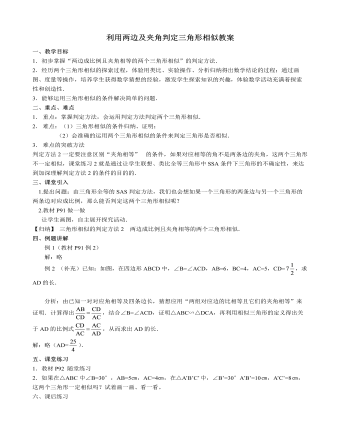
北师大初中数学九年级上册利用两边及夹角判定三角形相似2教案
一、教学目标1.初步掌握“两边成比例且夹角相等的两个三角形相似”的判定方法.2.经历两个三角形相似的探索过程,体验用类比、实验操作、分析归纳得出数学结论的过程;通过画图、度量等操作,培养学生获得数学猜想的经验,激发学生探索知识的兴趣,体验数学活动充满着探索性和创造性.3.能够运用三角形相似的条件解决简单的问题. 二、重点、难点1. 重点:掌握判定方法,会运用判定方法判定两个三角形相似.2. 难点:(1)三角形相似的条件归纳、证明;(2)会准确的运用两个三角形相似的条件来判定三角形是否相似.3. 难点的突破方法判定方法2一定要注意区别“夹角相等” 的条件,如果对应相等的角不是两条边的夹角,这两个三角形不一定相似,课堂练习2就是通过让学生联想、类比全等三角形中SSA条件下三角形的不确定性,来达到加深理解判定方法2的条件的目的的.
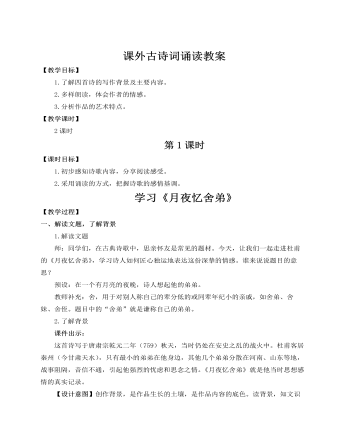
人教部编版语文九年级上册课外古诗词诵读(一)教案
二、初读,解读“早行”,感受意象的丰富1.寻读意象课件出示:诗人围绕“早行”一词,写了哪些典型特征的细节、景物?如何体现“早行”?学生自由诵读、思考交流。教师点拨:颔联十种景物的十个名词——鸡、声、茅、店、月、人、迹、板、桥、霜。一词一景,让我们获得广阔的想象空间,组成意韵丰富的画面。这就是古典诗歌的“意象叠加”法。预设:诗歌中处处体现“早行”,如“晨起动征铎”(清晨起床,车马铃声叮叮当当),“鸡声茅店月”(鸡鸣早看天),“人迹板桥霜”(莫道君行早,更有早行人),“枳花明驿墙”(“明”反衬“天暗”,说明“早”)。2.延读意象叠加的诗句课件出示:(1)枯藤老树昏鸦,小桥流水人家,古道西风瘦马。(马致远《天净沙·秋思》)(2)楼船夜雪瓜洲渡,铁马秋风大散关。(陆游《书愤》)(3)细草微风岸,危樯独夜舟。(杜甫《旅夜抒怀》)(4)桃李春风一杯酒,江湖夜雨十年灯。(黄庭坚《寄黄几复》)

人教部编版七年级语文上册课外古诗词诵读(二)教案
材料二:锦瑟无端五十弦,一弦一柱思华年。庄生晓梦迷蝴蝶,望帝春心托杜鹃。沧海月明珠有泪,蓝田日暖玉生烟。此情可待成追忆?只是当时已惘然。(李商隐《锦瑟》)相见时难别亦难,东风无力百花残。春蚕到死丝方尽,蜡炬成灰泪始干。晓镜但愁云鬓改,夜吟应觉月光寒。蓬山此去无多路,青鸟殷勤为探看。(李商隐《无题》)材料三:《十一月四日风雨大作》(其二)作于南宋光宗绍熙三年(1192)十一月四日。陆游自南宋孝宗淳熙十六年(1189)罢官后,闲居家乡山阴农村。当时诗人已经68岁,虽然年迈,但爱国热情丝毫未减,日夜惦念报效国家,可诗人收复国土的强烈愿望,在现实中已不可能实现,于是,在一个“风雨大作”的夜里,诗人触景生情,由情生思,在梦中实现了自己金戈铁马驰骋中原的愿望。死去元知万事空,但悲不见九州同。王师北定中原日,家祭无忘告乃翁。(陆游《示儿》)材料四:清朝同治四年(1865),谭嗣同出生于北京宣武城,其父谭继洵时任湖北巡抚。光绪元年(1875),谭嗣同10岁时,拜浏阳著名学者欧阳中鹄为师。
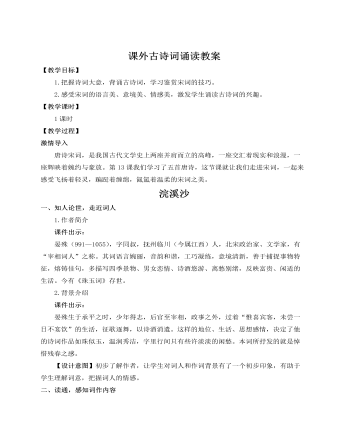
人教部编版语文八年级上册课外古诗词诵读教案
三、品读,感悟词人情怀1.品读“醉”意设问1:再次默读词作。想一想:这首词是围绕哪一个字来写的?从哪些地方可以看出来?预设 “醉”字。表现:沉醉不知归路;误入藕花深处。设问2:词人因何而“醉”?预设 因美酒和美景而“醉”。设问3:除了美景、美酒,还有什么会让李清照“醉”?预设 还有词人和自己的伙伴在一起的那种美好情谊,对年轻时那些美好生活的回忆,都让她深深陶醉。师小结:李清照的“醉”既是酒醉更是陶醉。其实不管“兴”也好,“记”也罢,“醉”也好,还是“误”也好,作者是“字字如金”。因为“兴”所以“醉”,因为“醉”所以“误”,因为“醉”,所以常常记得。2.品字悟情设问1:如何理解两个“争渡”表达出的情感?预设 两个“争渡”,表现了主人公急于从迷途中找寻出路的焦灼心情。正是由于“争渡”,所以又“惊起一滩鸥鹭”,把停栖在沙洲上的水鸟都吓飞了。至此,词戛然而止,言尽而意未尽,耐人寻味。

人教部编版语文八年级上册课外古诗词诵读教案
预设 反映了海边农村残破、荒凉的景象,表现了作者对下层人民的深切同情。【设计意图】“三分诗七分读”,学生反复诵读,与文本对话,感知诗歌的韵律和节奏,读出情味,为理解诗歌情感做铺垫。三、品读诗歌,含英咀华师:请同学们仔细品读这首诗,思考以下问题。设问1:曹植在海边看到了怎样的情景?预设 民不聊生,破败荒凉。其中,“寄身”三句,从生活环境、生活艰难和居住环境三个方面实写“边海民”的悲惨生活。海民寄身于“草野”,过着非人的生活,生吞活剥,巢息穴居,所以说“象禽兽”;他们不敢出来,怕被人发现、抓走,每天就钻在山林里边,所以说“行止依林阻”。一个“依”字把难民们的实际活动和恐惧心理都表现出来了。“狐兔翔我宇”一句通过对狐狸、兔子的描写,侧面描绘出海边贫民家庭条件的恶劣以及家园的破败。全诗正面描写与侧面烘托相结合,使海边贫民悲惨的生活图景跃然纸上。设问2:诗中哪一句最能体现作者的情感?
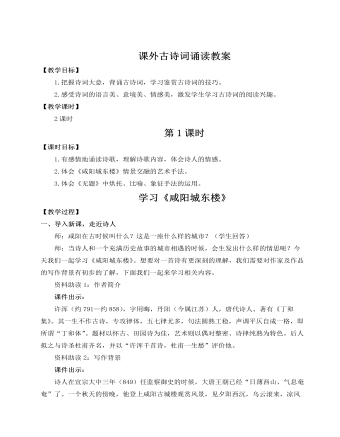
人教部编版语文九年级上册课外古诗词诵读(二)教案
课件出示:少年时指青年时期,从辛弃疾的生平看,这时的他正处于金人统治区内,看到沦陷区的人们在异族的奴役之下,作为血气方刚的爱国青年,油然而生收复失地的报国之志。因而这时的愁情也是真实存在的,那就是对沦陷区人民的同情,对国土沦丧的耻辱感,这时的愁,更多的是一种渴望收复中原、建立不世功业的志愿和动力,是昂扬而充满激情的。2.深入思考,体会“愁”的含蓄之美(1)比较少年时登楼与而今登楼的目的有何不同?预设:少年时登楼,是为了登高望远,抒发自己的豪情壮志。而今登楼,是为了排遣内心的悲愤之情。(2)是什么原因使词人“欲说还休”?预设:统治者处处排挤、打击他,他处处受猜忌,所以有愁不敢说。更主要的原因是,一生抱负付之流水,鬓发苍苍,功业无成,而又没有知音,无人理解。这种孤独的愁情,跟谁诉说,说了又有什么用,这中间也包含着对南宋朝廷的无限失望。因为这种失望,所以辛弃疾“欲说还休”。
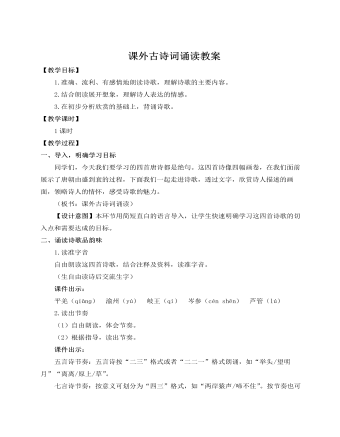
人教部编版七年级语文上册课外古诗词诵读(一)教案
(1)示例一(横向联想) 李白的送别诗:①“思君不见下渝州”,表达依依惜别的无限情思,可谓语短情长。②“仍怜故乡水,万里送行舟”,意思是“我”还是怜爱故乡的水,流过万里送“我”远行。这一句运用了拟人的修辞手法,将故乡水拟人化,借写故乡水有情,不远万里,依依不舍送“我”远别故乡,表达了诗人离开故乡时依依不舍、思念故乡的感情。③“孤帆远影碧空尽,唯见长江天际流。”这两句看起来似乎是写景,但在写景中包含着一个充满诗意的细节。李白一直把朋友送上船,船已经扬帆而去,而他还在江边目送远去的船帆。李白望着帆影,一直看到帆影逐渐模糊,消失在碧空的尽头,可见目送时间之长。帆影已经消失了,然而李白还在翘首凝望,这才注意到一江春水,在浩浩荡荡地流向远远的水天交接之处。“唯见长江天际流”,是眼前景象,可是谁又能说是单纯地写景呢?李白对朋友的一片深情,李白的向往,不正体现在这富有诗意的神驰目注之中吗?诗人的心潮起伏,不正像那浩浩东去的一江春水吗?
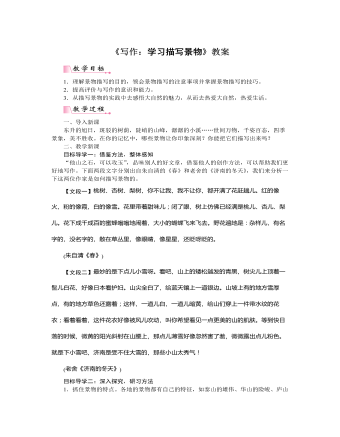
部编版语文八年级上册《写作:学习描写景物》教案
5.发挥想象。两段文字都运用了想象的手法。“闭了眼,树上仿佛已经满是桃儿、杏儿、梨儿”“看着看着,这件花衣好像被风儿吹动,叫你希望看见一点更美的山的肌肤”“那点儿薄雪好像忽然害了羞”,这些想象,既突出了景物的特点,又融入了作者的情感,可谓是一举两得。6.讲究描写的顺序。两段文字都采用空间顺序展开描写,景物的层次清晰。要注意观察的顺序,是由近及远,还是由远及近?是由上到下,还是由下到上?这是指空间的变换。还可以以时间的变化或游览的先后为顺序。这样,所描写的景物才不会杂乱无章。7.写景还要融入情感。“一切景语皆情语”。写景贵有情,在描绘客观景物的同时,要把自己的喜怒哀乐等思想感情融注到作品中去,使读者产生共鸣,进而给读者带来愉悦之情、陶醉之情,将读者带入特定的情景之中,受到美的熏陶,获得美的享受。如《从百草园到三味书屋》中“夏天百草园”一段“油蛉在这里低唱,蟋蟀们在这里弹琴”,在作者小时候听来,油蛉、蟋蟀的叫声犹如人在悠扬的琴声伴奏下婉转地低唱,其间传递着作者愉快、喜悦的心声,表达作者对大自然的喜爱和向往之情。目标导学三:实战演练描写你家乡一处有特色的景物,包括自然景物和社会景物,要求描写细致、生动,表达你对家乡的热爱之情。例文展示:
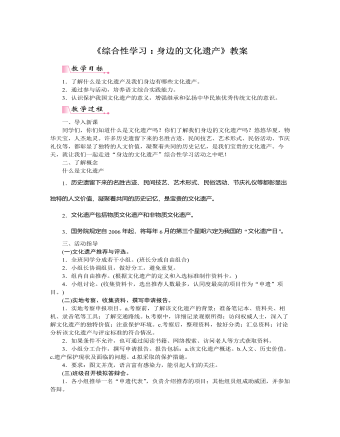
部编版语文八年级上册《综合性学习:身边的文化遗产》教案
当汽车行驶在乡间小道时,作家冯骥才再也没有了写作的冲动。往日白砖青瓦的农舍冒出了西洋式的尖顶和闪着异光的马赛克,炊烟袅袅,小桥流水成了埋藏在心底的梦。冯先生开始四处奔波,大声疾呼:救救我们的文化遗产!中国文化博大而宽广。她无处不在——融于书本,徜徉于江南小道,盘旋在峭壁飞檐……我们被这种浓厚的文化信息包围着,却道貌岸然地做着刽子手。忘记历史就是背叛。我们的文化遗产是历史的见证。秦始皇的兵马俑至今气宇轩昂地挺立着,隋朝大运河的波澜依旧拍打着千年的岸堤……孟江女的哭声凄婉悲恸,纤夫的号子似乎仍在耳边萦绕。沉淀了千年的沉浮、繁华、屈辱、悲愤,这些文化遗产烫帖了坎坷的心灵,将肃穆呈于世人。刀光剑影去了,长歌悲哭停止了,豪情厮杀消逝了……一切随着大江东去,只有千年松柏和着轻风耳语。





